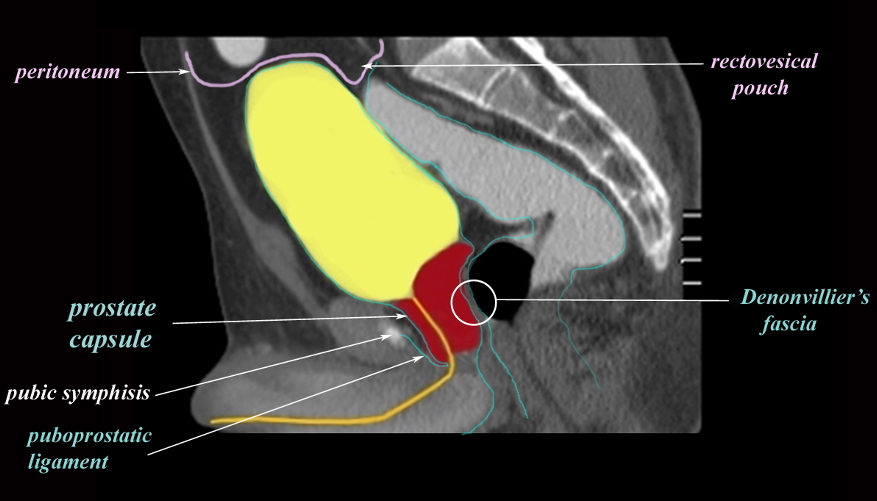The Common Vein Copyright 2010
Introduction
The prostate is surrounded by a firm fibrous capsule that is structurally composed of collagen, elastin, and smooth muscle. These fibers blend with the fibers of the puboprostatic ligament, anchoring the prostate to the posterior aspect of each of the pubic bones. The capsule itself lies within the sheath for the endopelvic fascia, which surrounds it laterally, anteriorly and posteriorly. Under this capsule are circularly oriented smooth muscle fibers and collagen-rich tissue that surround the urethra. The prostatic capsule is not present at the apex (inferiorly) where it transitions into the external sphincter, and is also absent at its base superiorly, where it transitions into the detrusor muscle of the bladder.
|
The Capsule of the Prostate |
|
The CTscan reflects a normal prostate (maroon overlay) seen in the sagittal plane. The bladder, prostate and the rectum are all extraperitoneal and are therefore not covered by peritoneum. Their covering is via a capsule which is common to the bladder and prostate (blue overlay). The rectum has its own covering that fuses with the posterior covering of the prostate to form Denovillier’s fascia (aka rectoprostatic fascia, or the rectovesical septum). The bladder is distended. (yellow overlay) The base of the prostate that abuts the bladder is free of a capsule as is the apex. Image Courtesy Ashley Davidoff Copyright 2010 99331c02g02b04.9 |
Functionally, the capsule provides a protective barrier to the prostate. In addition smooth muscle elements aid in the expulsion of prostatic secretions.
When prostate cancer spreads beyond the capsule it carries a poorer prognosis. Nevertheless, as the prostatic capsule is poorly defined at the apex and base, determining extension beyond the capsule at these levels makes this evaluation a challenging problem for the pathologist.
Treatment is rarely focused on the capsule itself, though attempt is made to resect the prostate with the capsule intact so that pathologic examination can determine if the disease is confined within the borders of the capsule.

